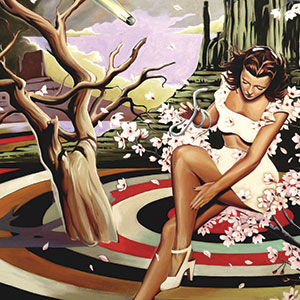
A mud-colored python wraps its body around a resting angel with magenta hair. She is unconcerned by its proximity and rests both of her hands against its curving belly. At the center of a target, a 1940s pin-up model holds the head of a gray garden snake between her thumb and index finger, its silvery length coils around her right forearm. Faded pink cherry blossoms surround them both as satellites race across the sky.
In two separate poses, the right arm of a naked saint is held aloft by the tail end of a black and white snake. Even chubby putti ride, cavort and wrestle with snakes in the paintings made by Anthony Riggs in his new exhibit at the Triton Museum of Art.
Walking around the gallery, Riggs explained his fascination with ophidian imagery: “A snake is a symbol of renewal and fertility. It sheds its skin.” He doesn’t paint them open-mouthed, baring fangs, poised to strike at prey. They’re just “hanging out”but as recurring characters in the dramatic narratives that his paintings depict. Every Act of Creation is an Act of Destruction (2014) features that magenta-haired angel and a second one with bright pink locks. The lower half of the painting gathers together an orchid, a cactus, a rhinoceros beetle and the aforementioned python. Centered at the top of this oil on canvas, a purple lotus in full bloom sends out dark pink stripes like the rays fanning out of a cartoon sun. At ground level, a Hokusai-like wave washes away the landscape behind two oil derricks and a shadowy outline of Monument Valley.
Leonardo da Vinci’s Virgin of the Rocks is not the first painting that comes to mind when you look at this collage and collision of color, form and meaning. Riggs’ work is both hyperrealthe beetle is nearly the size of an actual rhinocerosand surreal, because of all the illogical juxtapositions. But his approach to this collection of paintings is part of his ongoing investigation into a history of art that can also speak to the present. In this case, he looked for inspiration in Renaissance paintings and asked himself, “What could I paint today that could respond to da Vinci’s idea?” Virgin of the Rocks includes Jesus as an object of adoration, but he and his mother are fleeing the wrath of King Herod. As Riggs observed, “It has a sense of doom or deliverance.”
He also says that his work deals with “not actual science, but the way that popular culture perceives it. If we do good works, our science and technology can save the planet. We can save ourselves from the problems that we created.” If we don’t, the painting suggests that we might just as easily expect an environmental apocalypse. Riggs may have started with da Vinci and the Renaissance, but his work is a synthesis of different mythologies and belief systems. That’s how a lotus from the East communes with angels from the West.
Before setting paint to canvas, he makes a collage. “Collage is a fast way of getting me to the space where I want to paint.” It’s an organizing principle that gives him a sense of what should go where and when to edit a congested idea.
Riggs is by no means a minimalist, but he didn’t start out painting animated mashups of pop culture, science, religion and nature. At the beginning of his career, when he was figuring out who he was as a young man and an artist, Riggs painted abstract work in black and white. When you come across a painting like The Decolonization of Reason (2015), based on the legend of Saint George and the Dragon, it’s hard to imagine him ever forsaking color again.
In his version, Riggs has so skillfully incorporated a French floral wallpaper pattern from the 1800s that it looks like decoupage. He notes that the French borrowed the pattern, like his peacock-blue dragon, from the Chinese. The winged Saint George figure is suspended mid-air against the flowers and patches of rose paint that simulate torn scraps of some luxurious fabric.
This marriage of patterns and cultures shouldn’t work, but it does, especially in paintings like this one where the artist’s conscious efforts at storytelling are absorbed by the shapes and colors. When Riggs abandons the intellectual ideas that jump-start his narratives, the work balances out riotous moments of chaos with the harmony of his saturated palette. The paintings then are liberated from having to mean anything, and are simply beautiful.
Anthony Riggs
Thru Aug 5, Free
Triton Museum of Art, Santa Clara
tritonmuseum.org


